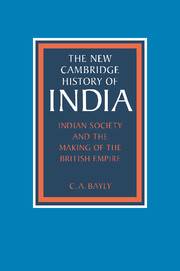Book contents
- Frontmatter
- Introduction
- 1 India in the eighteenth century: the formation of states and social groups
- 2 Indian capital and the emergence of colonial society
- 3 The crisis of the Indian state, 1780–1820
- 4 The consolidation and failure of the East India Company's state, 1818–57
- 5 Peasant and Brahmin: consolidating ‘traditional’ society
- 6 Rebellion and reconstruction
- Conclusion: the first age of colonialism in India
- Glossary of indian terms
- Bibliographical essay
- Index
- THE NEW CAMBRIDGE HISTORY OF INDIA
- Plate Section"
- References
1 - India in the eighteenth century: the formation of states and social groups
Published online by Cambridge University Press: 28 March 2008
- Frontmatter
- Introduction
- 1 India in the eighteenth century: the formation of states and social groups
- 2 Indian capital and the emergence of colonial society
- 3 The crisis of the Indian state, 1780–1820
- 4 The consolidation and failure of the East India Company's state, 1818–57
- 5 Peasant and Brahmin: consolidating ‘traditional’ society
- 6 Rebellion and reconstruction
- Conclusion: the first age of colonialism in India
- Glossary of indian terms
- Bibliographical essay
- Index
- THE NEW CAMBRIDGE HISTORY OF INDIA
- Plate Section"
- References
Summary
India in 1700 had a population of some 180 million people, a figure which represented about 20 per cent of the population of the entire world. Over much of this huge land mass from Kashmir in the north to the upland plateau of the Deccan in the south, the Mughal dynasty at Delhi fought to maintain an hegemony which had been consolidated in the second half of the sixteenth century by the Emperor Akbar. In the farther south of the peninsula Hindu warrior chieftains vied for control of villages, many claiming parcels of the authority of the Hindu Vijayanagar kingdom which had faded from the scene in the later sixteenth century.
Under the Emperor Aurangzeb (1658–1707) the Muslim power at Delhi still shook the world. The Emperor remained capable of commanding a remarkable concentration of soldiers and treasure, if only in certain places and during some months of the year. In the 1680s the Mughals had destroyed the last independent Muslim kingdoms of the Deccan. In the following generation they continued to expand. Their lieutenants pushed down to the south-eastern coast and began to demand tribute from the Hindu warrior chiefs of all but the most remote parts of the former Vijayanagar domain. In 1689 they had beaten off the threat from the Hindu Maratha warriors of the western Deccan and had savagely executed their war-leader, Shambaji. In 1700 the Maratha capital, Satara, was taken by the Emperor's siege trains. Even in the north Mughal power was still strong.
Keywords
- Type
- Chapter
- Information
- Indian Society and the Making of the British Empire , pp. 7 - 44Publisher: Cambridge University PressPrint publication year: 1988
References
- 2
- Cited by



